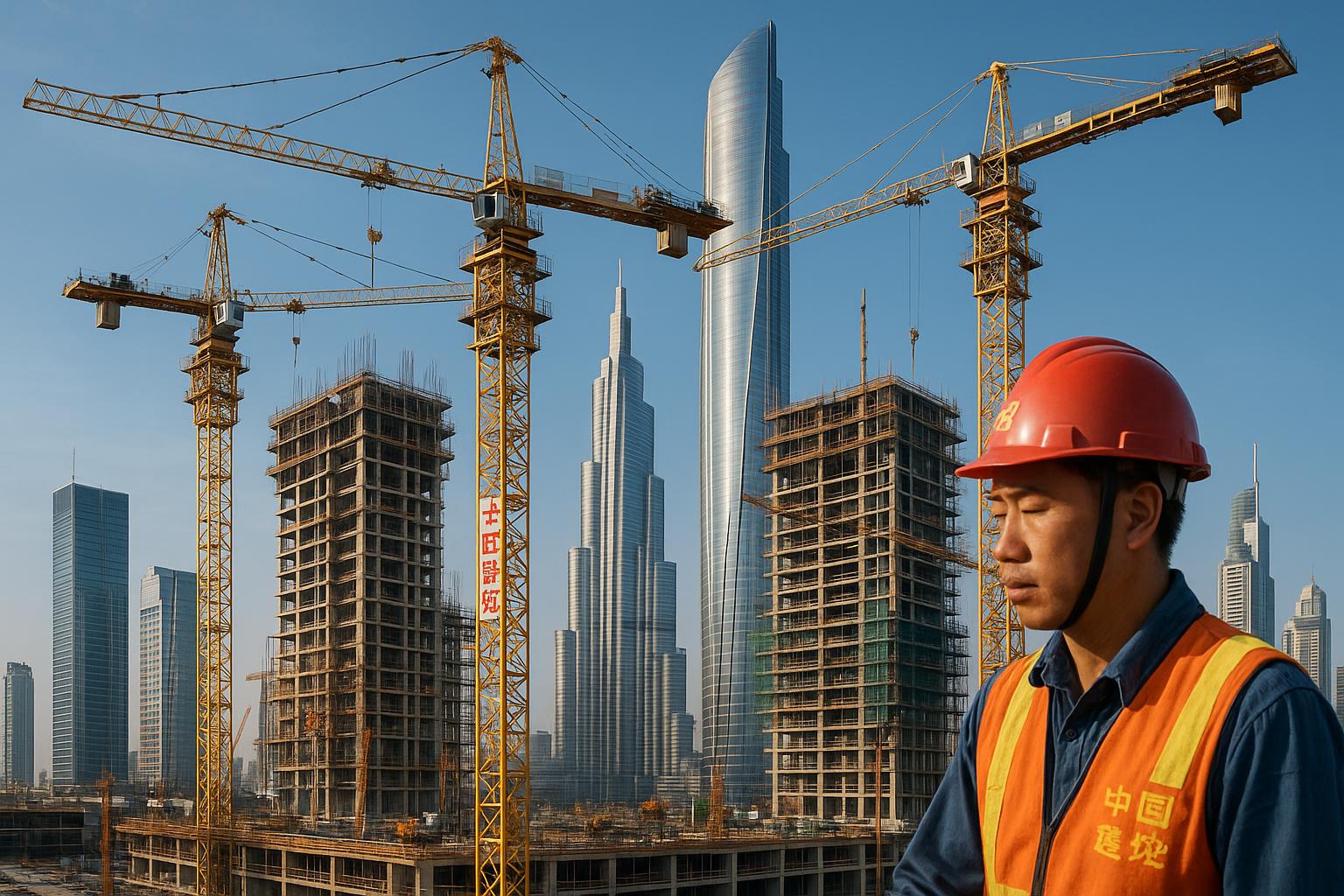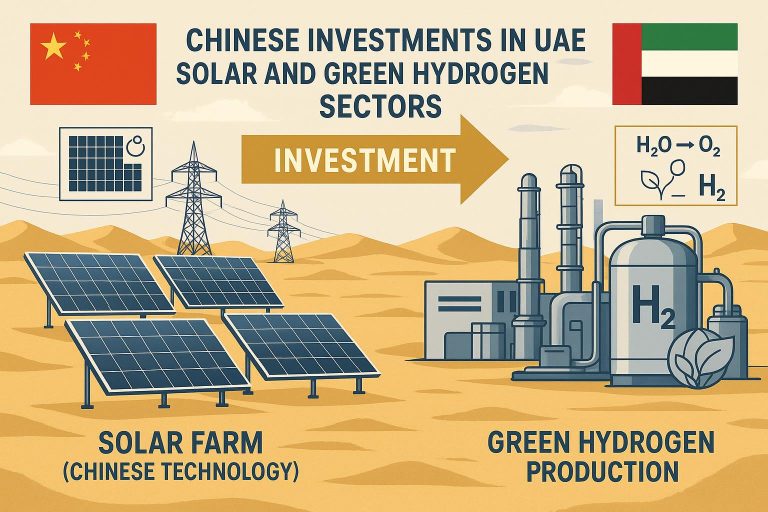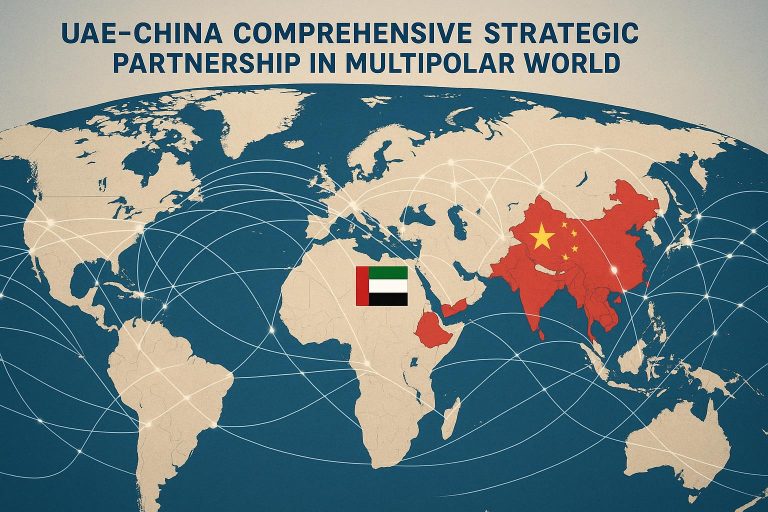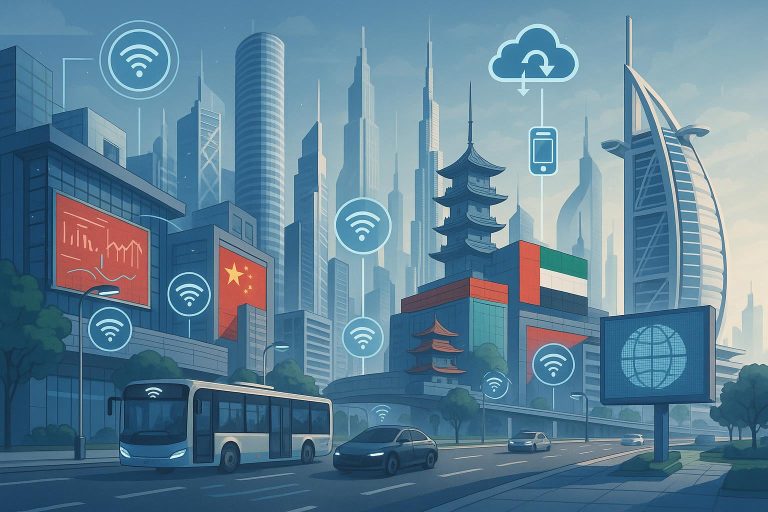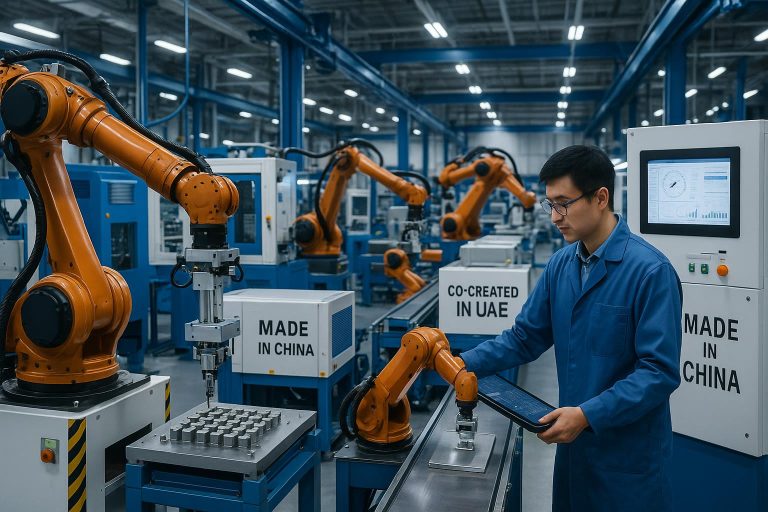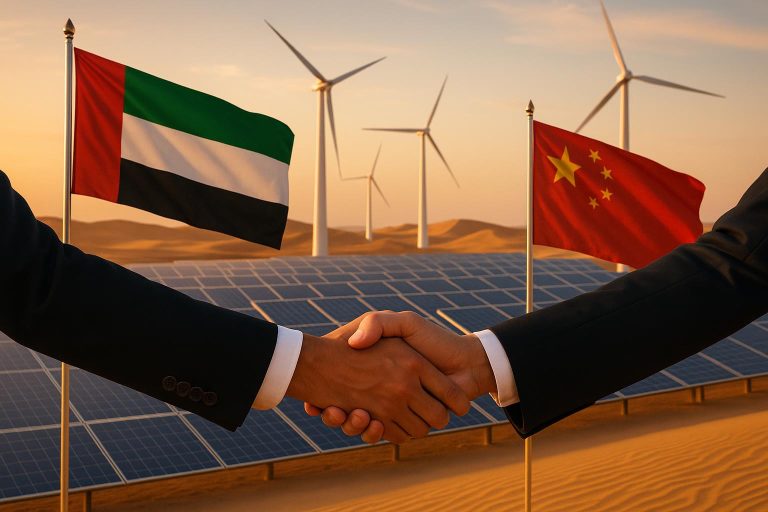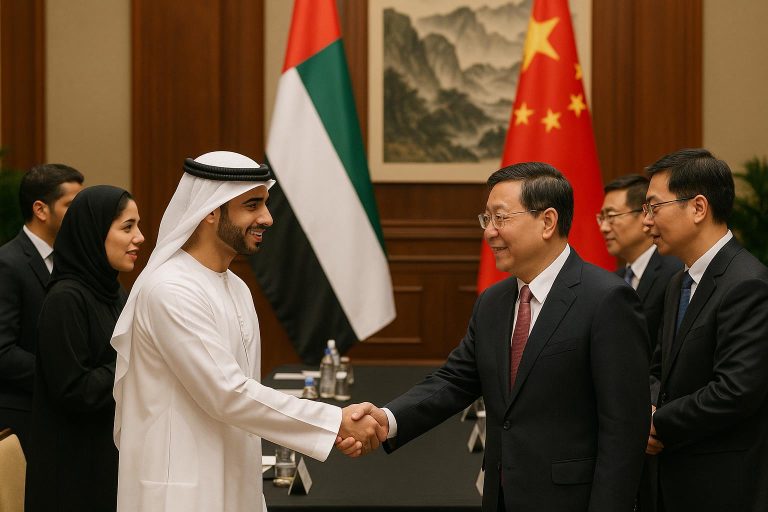Building Skylines, Forging Bonds: The Enduring Role of Chinese Construction and Engineering in the UAE’s Real Estate Landscape.
Executive Summary
The United Arab Emirates (UAE) and China have cultivated a robust and comprehensive strategic partnership, marked by unprecedented growth in bilateral trade and investment. With bilateral trade reaching a record $101.8 billion in 2024, and over 15,000 Chinese firms operating in the UAE, China has emerged as a pivotal force in the Emirates’ economic diversification and infrastructure development. This article examines the profound impact of Chinese construction and engineering enterprises on the UAE’s dynamic real estate sector, highlighting their contributions to iconic skylines and critical infrastructure projects. While acknowledging the positive trajectory and strategic alignment, it also critically assesses the opportunities for deeper collaboration, the challenges inherent in such a rapidly evolving partnership, and offers strategic recommendations for sustainable growth. The analysis underscores the mutual benefits derived from this partnership, positioning the UAE as a key gateway for China’s Belt and Road Initiative in the Middle East.
Introduction
The relationship between the United Arab Emirates and the People’s Republic of China has transcended traditional trade ties to evolve into a comprehensive strategic partnership, formally established in 2018. This partnership is underpinned by shared visions for economic growth, innovation, and regional stability, manifesting in significant collaborations across diverse sectors. Among these, the indelible mark left by Chinese construction and engineering firms on the UAE’s urban and infrastructural landscape stands out as a testament to this deepening bond. From towering skyscrapers that define modern cityscapes to critical logistical hubs facilitating global trade, Chinese expertise and investment have played an enduring role in shaping the UAE’s ambitious development agenda. This analytical article delves into the multifaceted dimensions of this collaboration, exploring how Chinese enterprises are not merely building structures but are actively forging economic and cultural ties. It will provide a detailed examination of the current landscape of bilateral cooperation, identify key opportunities and strategic growth drivers, address critical challenges, present a compelling case study, and conclude with a forward-looking perspective and actionable recommendations for future engagement. The aim is to offer a balanced, positive, yet critically informed perspective on this vital partnership for the UAE China Chamber of Commerce platform.
The Current Landscape of Bilateral Cooperation
The economic and strategic ties between the UAE and China have witnessed exponential growth, transforming into a multifaceted partnership that underpins regional stability and global economic integration. This deepening relationship is vividly reflected in the remarkable surge in bilateral trade, which reached an unprecedented $101.8 billion in 2024, marking an astounding 800-fold increase since 1984. This makes the UAE China’s largest export market in the Middle East and its second-largest trading partner in the region, while China consistently remains the UAE’s largest trading partner. The presence of over 15,000 Chinese firms operating within the UAE further solidifies this economic interdependence, demonstrating a significant commitment to the Emirates’ market and its strategic position [1].
Beyond trade, investment flows have also seen substantial expansion. By the end of 2023, UAE investments in China had soared to $4.5 billion, representing a remarkable 96% increase from the previous year. This upward trajectory is a clear indicator of the mutual trust and confidence between the two nations, fostering an environment conducive to cross-border capital deployment [2].
The strategic framework underpinning this robust relationship was formally cemented in 2018 with the establishment of a Comprehensive Strategic Partnership. This high-level agreement paved the way for enhanced cooperation across various domains, including the formation of the UAE-China Investment and Economic Cooperation Working Group. Regular high-level diplomatic engagements and the signing of strategic agreements further underscore the commitment of both governments to nurture and expand this vital alliance [3].
Cooperation extends across a diverse array of sectors, reflecting the comprehensive nature of the partnership. In Energy & Clean Energy, significant investments are being made in solar and wind power projects, exemplified by the Masdar-China Silk Road Fund MoU for renewable energy initiatives within Belt and Road Initiative (BRI) countries. The Infrastructure & Logistics sector has seen landmark projects such as the COSCO terminal at Khalifa Port and the establishment of the China-UAE Industrial Capacity Zone, positioning the UAE as a crucial Gulf gateway for Chinese trade and investment. The Technology & AI domain is characterized by numerous cooperation agreements and digital transformation initiatives, with both nations keen on leveraging advanced technologies for economic growth. Furthermore, Trade & Free Zones continue to thrive through partnerships like JAFZA’s collaborations with Chinese free trade zones and DP World’s extensive engagements. Finally, Finance & Investment remains a cornerstone, with the UAE being a significant recipient of BRI projects, attracting $3.1 billion in investments, alongside ongoing efforts to facilitate cross-border financial flows [4].
Recent developments in 2024-2025 further highlight the dynamism of this partnership. Multiple Memoranda of Understanding (MoUs) have been signed between various chambers and organizations, fostering deeper sectoral collaborations. High-level visits and diplomatic engagements continue to reinforce political will, with an increasing focus on new economy sectors, entrepreneurship, tourism, and aviation. Geographically, Abu Dhabi has emerged as a primary investment hub, while Dubai maintains its pivotal role in trade facilitation, complemented by free zone partnerships across all emirates, collectively contributing to a diversified and resilient bilateral relationship [5].
Opportunities and Strategic Growth Drivers
The enduring partnership between the UAE and China presents a fertile ground for strategic growth, particularly within the real estate and related sectors, driven by a confluence of economic imperatives, technological advancements, and shared developmental goals. Chinese construction and engineering firms are uniquely positioned to capitalize on these opportunities, leveraging their expertise, scale, and financial backing to contribute significantly to the UAE’s ambitious development vision.
One primary driver is the UAE’s continuous investment in Infrastructure & Logistics. The expansion of ports, airports, and free zones, such as the COSCO terminal at Khalifa Port and the China-UAE Industrial Capacity Zone, creates sustained demand for large-scale construction projects. Chinese companies, with their proven track record in delivering complex infrastructure, are instrumental in enhancing the UAE’s connectivity and its role as a global trade hub. The development of logistics hubs, exemplified by JINGDONG Property’s first Middle East logistics hub in Dubai and JD.com’s smart supply chain technologies, further necessitates advanced construction and engineering solutions to build state-of-the-art warehousing and distribution facilities [6].
The burgeoning Technology & AI sector also offers substantial opportunities. The UAE’s drive towards digital transformation and smart city initiatives, as explored by Digital Dubai in Shenzhen, requires the construction of advanced data centers, smart infrastructure, and technologically integrated urban developments. Chinese firms, often at the forefront of these technologies, can bring innovative construction methods and smart building solutions to the UAE, integrating AI and IoT into new real estate projects. The $5 billion partnership between UAE and China for AI, renewable energy, and infrastructure underscores this potential [7].
Tourism & Hospitality remains a significant growth area. With the 2025 China-GCC tourism trade fair in Dubai and the UAE targeting a $1 billion tourism opportunity from China, there is an increasing demand for new hotels, resorts, shopping centers, and hospitality infrastructure. Chinese construction companies can play a pivotal role in developing these facilities, catering to the growing influx of Chinese tourists and investors. China Tourism Group’s exploration of UAE hospitality sector investments further highlights this trend [8].
Furthermore, the UAE’s focus on Agriculture & Food Security is opening new avenues for specialized construction. Projects like the $33 million smart agricultural project by Silal and China’s Shouguang Vegetable Group, and SVG’s investment in a 100,000m² Agritech facility in Al Ain, require advanced greenhouse structures, hydroponic farms, and climate-controlled facilities. Chinese engineering expertise in these areas can support the UAE’s goal of enhancing local food production capabilities [9].
In the Healthcare & Pharmaceuticals sector, the UAE’s ambition to become a regional medical hub necessitates the construction of modern hospitals, research facilities, and pharmaceutical manufacturing plants. The acquisition of UCB Pharma’s mature business in China by UAE’s Mubadala and ongoing medical technology partnerships indicate a growing demand for specialized infrastructure that Chinese construction firms can deliver [10].
Finally, the Financial Services & Fintech sector, with initiatives like China’s CIPS and UAE central bank cross-border payment cooperation, drives demand for secure and technologically advanced financial infrastructure. While not directly construction, the growth in this sector indirectly fuels commercial real estate development, including office spaces and innovation hubs, where Chinese construction and engineering can contribute to creating modern, efficient environments [11].
These diverse sectors collectively represent strategic growth drivers where Chinese construction and engineering firms can continue to play an enduring and expanding role, contributing not only to the physical landscape but also to the economic diversification and resilience of the UAE.
Challenges and Critical Considerations
While the UAE-China partnership in construction and real estate is undeniably robust and mutually beneficial, it is not without its complexities and critical considerations that require careful navigation to ensure sustained growth and deeper integration. Addressing these challenges proactively will be crucial for the long-term success and evolution of this strategic alliance.
One significant area of consideration revolves around regulatory and cultural differences. Chinese firms operating in the UAE must adapt to local regulations, business practices, and cultural nuances, which can sometimes differ significantly from those in China. This includes understanding local labor laws, environmental standards, and procurement processes. Bridging this gap requires continuous investment in local expertise, cultural training, and fostering strong relationships with local partners to ensure compliance and smooth project execution.
Another critical aspect is market competition and differentiation. The UAE’s real estate and construction sectors are highly competitive, with numerous international players vying for projects. Chinese companies, while offering competitive pricing and efficiency, must increasingly focus on innovation, sustainable building practices, and high-value-added services to differentiate themselves. This includes adopting advanced technologies, green building certifications, and bespoke design solutions that cater to the evolving demands of the UAE market. The emphasis on new economy sectors and entrepreneurship in recent developments suggests a shift towards more sophisticated and specialized projects, demanding a higher level of innovation from all participants [5].
Furthermore, geopolitical dynamics and global economic fluctuations can introduce uncertainties. As a global economic hub, the UAE is susceptible to broader international economic trends, which can impact investment flows and project viability. Similarly, the geopolitical landscape can influence trade routes, supply chains, and investor confidence. Both nations must continue to strengthen their strategic dialogue and economic resilience to mitigate these external risks and maintain a stable environment for bilateral investment. The strategic positioning of entities like G42 between major global markets highlights the need for careful navigation of international relations [7].
Finally, ensuring sustainable development and community integration is paramount. Large-scale construction projects, while economically beneficial, must also consider their long-term environmental and social impacts. Chinese firms have an opportunity to lead in adopting best practices for sustainability, contributing positively to the UAE’s vision for a green economy and ensuring that developments are well-integrated into existing communities, fostering local employment and skill development. This critical consideration aligns with the UAE’s broader commitment to sustainable urban development and social progress.
Addressing these challenges through enhanced communication, strategic adaptation, and a commitment to shared values will not only overcome potential hurdles but also deepen the trust and effectiveness of the UAE-China partnership in shaping the future of the region’s real estate landscape.
Case Study Spotlight: The China-UAE Industrial Capacity Cooperation Zone
To illustrate the tangible impact of Chinese construction and engineering in the UAE, the China-UAE Industrial Capacity Cooperation Zone (ICCZ) in Khalifa Port, Abu Dhabi, stands as a prime example. This ambitious project, a cornerstone of the Belt and Road Initiative (BRI) in the Middle East, is developed by Jiangsu Provincial Overseas Cooperation and Investment Company (JOCIC) and serves as a vital platform for Chinese enterprises to establish manufacturing and logistics operations in the UAE [4].
The ICCZ is not merely an industrial park; it represents a significant undertaking in infrastructure development and real estate construction. It involves the construction of factories, warehouses, administrative buildings, and supporting infrastructure such as roads, utilities, and residential facilities for workers. Chinese construction and engineering firms have been instrumental in transforming vast tracts of land into a modern industrial hub, demonstrating their capacity for large-scale, integrated development projects. This zone leverages the strategic location of Khalifa Port, enhancing the UAE’s position as a critical logistics hub for China-Middle East trade and facilitating industrial capacity transfer [6].
The success of the ICCZ showcases how Chinese construction and engineering expertise directly contributes to the UAE’s economic diversification goals, attracting foreign direct investment, creating employment opportunities, and fostering local industrial growth. It exemplifies the enduring role of Chinese firms in building the physical infrastructure that underpins the UAE’s economic future, forging stronger economic bonds through concrete development.
Future Outlook and Strategic Recommendations
The future of the UAE-China partnership in the real estate and construction sectors is poised for continued expansion, driven by shared strategic interests and evolving global dynamics. The trajectory indicates a shift towards more sophisticated, technology-driven, and sustainable projects, moving beyond traditional infrastructure to encompass new economy sectors. To maximize this potential, several strategic recommendations can be considered.
Firstly, Deepen Collaboration in Smart City Development and AI Integration. As both nations prioritize digital transformation, Chinese construction and engineering firms should increasingly focus on integrating AI, IoT, and smart technologies into urban planning and building design. This includes developing smart infrastructure for sectors like healthcare, logistics, and tourism, aligning with the UAE’s vision for advanced urban environments and China’s technological prowess [7].
Secondly, Prioritize Green Construction and Sustainable Development. With global emphasis on climate action, Chinese firms can lead in adopting and implementing sustainable building materials, energy-efficient designs, and environmentally friendly construction practices in the UAE. This aligns with the UAE’s commitment to a green economy and offers a competitive advantage in a market increasingly valuing sustainability [9].
Thirdly, Foster Local Talent Development and Knowledge Transfer. To ensure long-term sustainability and local integration, Chinese companies should invest further in training and employing local Emirati talent, facilitating knowledge transfer in advanced construction techniques, project management, and technological innovation. This will strengthen local capabilities and deepen the bonds between the two nations.
Fourthly, Explore Niche and High-Value Sectors. Beyond large-scale infrastructure, there is significant potential in specialized real estate segments such as Agritech facilities, advanced healthcare infrastructure, and high-tech industrial parks. Chinese firms can leverage their expertise in these areas to meet the UAE’s specific needs for food security and advanced medical services [9, 10].
Finally, Enhance Financial and Legal Frameworks for Cross-Border Investment. Continued efforts to streamline investment processes, harmonize regulatory frameworks, and facilitate cross-border financial transactions will further encourage Chinese investment in the UAE’s real estate market and vice versa. The ongoing cooperation in financial services and fintech provides a strong foundation for this [11].
By embracing these recommendations, the UAE-China partnership can continue to build not just skylines, but also a resilient, innovative, and mutually prosperous future.
Conclusion
The enduring partnership between the UAE and China, cemented by a comprehensive strategic framework, has profoundly reshaped the economic and urban landscape of the Emirates. Chinese construction and engineering firms have emerged as indispensable partners in the UAE’s ambitious development journey, contributing significantly to its iconic skylines, advanced infrastructure, and diversified economy. From record-breaking bilateral trade figures to substantial cross-border investments and collaborative ventures across key sectors like energy, logistics, technology, and real estate, the synergy between these two nations is undeniable.
While opportunities for growth are vast, particularly in smart city development, green construction, and high-value niche sectors, critical considerations such as navigating regulatory differences, fostering innovation in a competitive market, and adapting to geopolitical shifts remain paramount. By proactively addressing these challenges and embracing strategic recommendations for deeper collaboration, talent development, and sustainable practices, the UAE and China are not merely building physical structures; they are forging stronger economic bonds and a shared future of prosperity. This partnership serves as a powerful testament to the potential of international cooperation in driving progress and innovation in the 21st century.
References
[1] UAE-China Bilateral Investment Research Findings. (2025). Key Statistics and Trade Data.
[2] UAE-China Bilateral Investment Research Findings. (2025). Key Statistics and Trade Data.
[3] UAE-China Bilateral Investment Research Findings. (2025). Strategic Partnership Framework.
[4] UAE-China Bilateral Investment Research Findings. (2025). Key Cooperation Sectors Identified.
[5] UAE-China Bilateral Investment Research Findings. (2025). Recent Developments (2024-2025) & Geographic Focus Areas.
[6] UAE-China Bilateral Investment Research Findings. (2025). Infrastructure & Logistics; Logistics & Supply Chain.
[7] UAE-China Bilateral Investment Research Findings. (2025). Technology & AI; Artificial Intelligence & Digital Transformation.
[8] UAE-China Bilateral Investment Research Findings. (2025). Tourism & Hospitality.
[9] UAE-China Bilateral Investment Research Findings. (2025). Agriculture & Food Security.
[10] UAE-China Bilateral Investment Research Findings. (2025). Healthcare & Pharmaceuticals.
[11] UAE-China Bilateral Investment Research Findings. (2025). Financial Services & Fintech.

